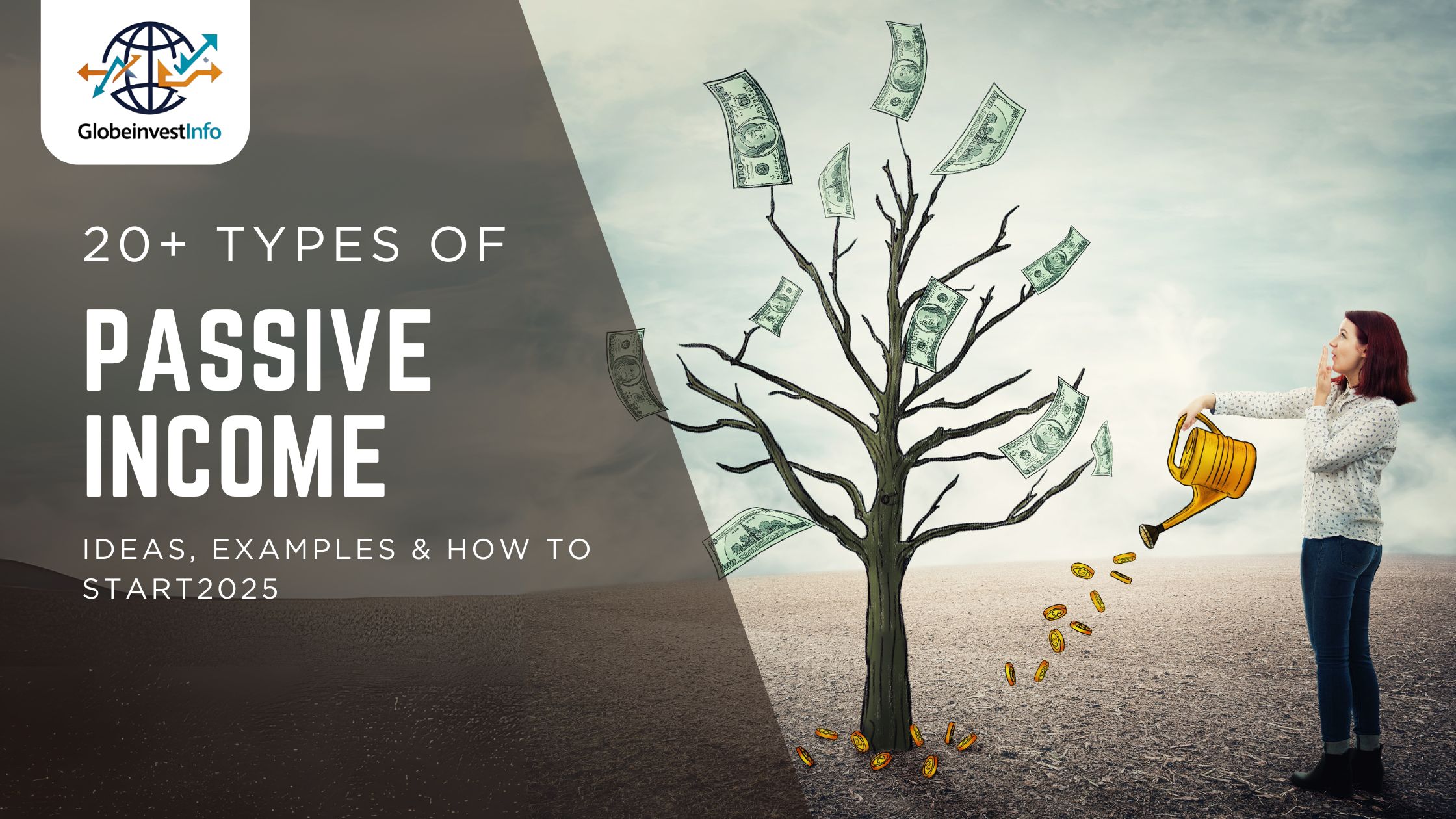Many people want financial freedom, but most rely only on a single paycheck. That’s risky because jobs can disappear, markets can change, and unexpected expenses often arrive at the worst time. The answer many turn to is passive income — money that flows even when you’re not actively working. But most guides online only list random ideas without showing how they work, what they cost, or who they’re right for.
This guide from GlobeInvestInfo is different. You’ll get a complete look at more than 20 types of passive income, with practical examples, risk levels, and step-by-step tips to get started. Whether you have $100 or $100,000 to invest, you’ll find clear options to build income streams that support your goals.
What Is Passive Income?
Passive income is money earned with little ongoing effort after the initial setup. It’s not “free money,” but it can become a steady stream once built.
- Active income = wages or salary from your time and labor.
- Passive income = earnings that continue without direct daily work.
Examples include dividends from stocks, rental property earnings, or royalties from a book. Some require upfront money, others require time and skill. A few combine both.
Key takeaway: Passive income allows you to decouple time from money, making financial independence more realistic.
Why Passive Income Matters
Building passive income matters for three reasons:
- Stability – Multiple streams protect you if one income source fails.
- Freedom – It can cover living costs, giving you more control over how you spend your time.
- Wealth growth – Many types of passive income compound over time, increasing your net worth.
For example:
- A rental property might earn $500/month while its value appreciates.
- Dividend stocks can reinvest automatically, growing your holdings.
- A digital product can sell thousands of copies worldwide while you sleep.
Types of Passive Income: The Complete Framework
Instead of a random list, it’s easier to think of passive income in categories.
Investment-Based Income
You put money to work, and it generates returns. Examples: dividends, bonds, REITs.
Asset-Based Income
You own something people pay to use. Examples: real estate, cars, vending machines.
Business-Based Income
You set up a system that earns with minimal daily effort. Examples: e-commerce, affiliate sites.
Digital Income
Products, content, or software that sell online. Examples: courses, ebooks, SaaS.
Royalty & Intellectual Property Income
Earnings from creative or patented work. Examples: music, books, patents.
This framework helps you see where each idea fits, and what suits your situation best.
20+ Types of Passive Income (With How to Start)
Below are the best types of passive income, with examples, startup needs, and tips.
1. Dividend Stocks
- How it works: You buy shares in companies that pay regular dividends.
- Startup cost: As little as $100 via brokerages like Fidelity or Charles Schwab.
- Risk level: Medium — stock prices can fluctuate.
- ROI: 2–5% average yield per year.
- Best for: Investors seeking steady returns with reinvestment potential.
2. Real Estate Rental Property
- How it works: Buy a property and rent it out.
- Startup cost: $20,000+ for down payment.
- Risk level: Medium-high — depends on tenants, market shifts.
- ROI: 6–10% typical cash-on-cash return.
- Tip: Use property management to reduce hands-on work.
3. Real Estate Investment Trusts (REITs)
- How it works: Invest in companies that own real estate portfolios.
- Startup cost: $500–$1,000.
- Risk level: Medium.
- ROI: 3–7% dividend yield.
- Best for: Investors who want real estate exposure without managing property.
4. Bonds & Fixed-Income Securities
- How it works: You lend money to governments or corporations for interest payments.
- Startup cost: $1,000+ typical.
- Risk level: Low-medium.
- ROI: 2–5% depending on maturity and issuer.
- Best for: Conservative investors seeking predictable income.
5. High-Yield Savings Accounts & CDs
- How it works: Banks pay interest on deposits.
- Startup cost: As little as $100.
- Risk level: Very low — FDIC insured in the US.
- ROI: 3–5% annual percentage yield (APY) in current rates.
- Best for: Safe short-term passive income.
6. Peer-to-Peer Lending
- How it works: You lend money to individuals or small businesses via platforms like Prosper or LendingClub.
- Startup cost: $500 minimum on most platforms.
- Risk level: Medium-high — depends on borrower repayment.
- ROI: 5–10% annual returns possible.
- Tip: Diversify across many loans to reduce risk.
7. Crowdfunded Real Estate
- How it works: Invest small amounts into large property projects through platforms like Fundrise.
- Startup cost: $500–$1,000.
- Risk level: Medium — tied to property performance.
- ROI: 7–12% average long-term.
- Best for: Investors wanting property exposure without direct ownership.
8. Airbnb & Short-Term Rentals
- How it works: Rent out your property, spare room, or vacation home.
- Startup cost: Variable — depends on property.
- Risk level: Medium — affected by demand, regulations, and upkeep.
- ROI: Often higher than long-term rentals, but more variable.
- Tip: Automate bookings and cleaning with services to reduce time spent.
9. Vending Machines & ATMs
- How it works: Place machines in high-traffic areas and earn per use.
- Startup cost: $2,000–$10,000 per machine.
- Risk level: Medium — depends on location.
- ROI: Can pay back investment in 12–18 months with good placement.
- Best for: Owners who want physical assets with cash flow.
10. Car Rentals & Car Sharing
- How it works: Rent out your car through services like Turo or Getaround.
- Startup cost: A car in good condition.
- Risk level: Medium — wear and tear, insurance claims possible.
- ROI: $300–$1,000/month depending on demand and location.
- Tip: Best for urban areas with steady demand.
Online & Digital Passive Income Ideas
These options often require upfront work, but once set up, they can earn for years.
11. Blogging & Display Ads
- How it works: Create a niche blog, monetize with ads via Google AdSense or Mediavine.
- Startup cost: $100 for hosting and domain.
- Risk level: Medium — success depends on SEO and traffic.
- ROI: From $100/month hobby blogs to $10k+/month authority sites.
- Best for: Writers and creators who can produce consistent content.
12. Affiliate Marketing
- How it works: Promote products online and earn a commission per sale.
- Startup cost: Website or social media presence.
- Risk level: Medium.
- ROI: Scales from small side income to full-time business.
- Tip: Focus on evergreen niches like finance, health, or software.
13. YouTube Channel
- How it works: Upload videos, earn from ads, sponsorships, and affiliates.
- Startup cost: Basic camera or smartphone.
- Risk level: Medium-high — depends on content growth.
- ROI: Top channels earn thousands monthly.
- Best for: Creators comfortable on video.
14. Online Courses & Digital Products
- How it works: Create and sell ebooks, templates, or training on platforms like Teachable or Gumroad.
- Startup cost: $100–$500 for tools.
- Risk level: Low-medium.
- ROI: Unlimited — depends on topic demand.
- Tip: Choose subjects with ongoing demand (Excel, investing, marketing).
15. Stock Photography & Video
- How it works: Upload photos/videos to sites like Shutterstock, earn royalties per download.
- Startup cost: Camera gear or even a smartphone.
- Risk level: Low — but income can be slow to grow.
- ROI: Typically small per sale, but passive over time.
Royalties & Intellectual Property
16. Book Publishing (Print or Kindle)
- How it works: Self-publish on Amazon Kindle Direct Publishing (KDP).
- Startup cost: Time to write, optional editing/cover design costs.
- Risk level: Medium — success depends on niche.
- ROI: $100–$10,000+ per year if book sells consistently.
17. Music & Audio Royalties
- How it works: Upload music to Spotify, iTunes, or stock music libraries.
- Startup cost: Recording equipment/software.
- Risk level: Medium-high.
- ROI: Variable — from a few dollars to thousands monthly.
- Tip: Consider royalty-free stock music for steady downloads.
18. Licensing Patents or Inventions
- How it works: License intellectual property to companies for royalties.
- Startup cost: Patent application fees ($5,000+ typical).
- Risk level: High — depends on product success.
- ROI: Can be large if product gains traction.
- Best for: Inventors with unique products.
Business & Semi-Passive Income
19. Silent Partnerships
- How it works: Invest in a business as a partner without managing operations.
- Startup cost: $10,000+.
- Risk level: High — depends on business success.
- ROI: Profit share can be 10–20% yearly if business thrives.
20. E-Commerce with Dropshipping or Print-on-Demand
- How it works: Sell products without holding inventory. Suppliers handle fulfillment.
- Startup cost: $500–$1,000 for store setup and ads.
- Risk level: Medium.
- ROI: Scales with traffic and marketing.
- Tip: Choose evergreen niches and automate as much as possible.
21. Software or Mobile Apps
- How it works: Develop an app or SaaS that people subscribe to.
- Startup cost: $2,000+ for development.
- Risk level: Medium-high.
- ROI: Recurring revenue can be large if adoption is strong.
- Best for: Developers or entrepreneurs willing to outsource coding.
Comparison Table: Best Types of Passive Income
| Income Idea | Startup Cost | Risk Level | ROI Range | Best For |
|---|---|---|---|---|
| Dividend Stocks | $100+ | Medium | 2–5% | Beginner investors |
| Rental Property | $20,000+ | Medium-High | 6–10% | Long-term wealth builders |
| REITs | $500+ | Medium | 3–7% | Low-hassle real estate investors |
| Peer-to-Peer Lending | $500+ | Medium-High | 5–10% | Income seekers with risk tolerance |
| Airbnb | Varies | Medium | High ROI | Property owners in high-demand areas |
| Blogging | $100+ | Medium | Wide | Writers, educators |
| YouTube | Free–$500 | Medium-High | Wide | Video creators |
| Online Courses | $100–$500 | Low-Medium | Wide | Subject experts |
| Patents/Licensing | $5,000+ | High | Wide | Inventors |
| Silent Partnerships | $10,000+ | High | 10–20% | Investors with capital |
Passive Income Taxes and Legal Considerations
Passive income is not tax-free. How it’s taxed depends on the source and your country of residence.
- Dividends – Often taxed at different rates than regular income. In the US, “qualified dividends” may be taxed at 0–20%.
- Rental Income – Taxed as ordinary income, but expenses like mortgage interest, repairs, and depreciation can reduce liability.
- Capital Gains – If you sell an investment property or stock, profits are taxed separately.
- Royalties – Count as income and must be reported.
- Interest Income – Savings accounts, bonds, and CDs are usually taxed as regular income.
Legal tip: Many investors set up an LLC for rental property or online businesses. This can provide liability protection and, in some cases, tax advantages. Always check with a licensed CPA or tax advisor in your country.
Common Mistakes With Passive Income
- Expecting instant results – Most ideas take months or years to scale.
- Confusing passive with no work – Almost all streams need setup and occasional upkeep.
- Overinvesting in one source – Relying only on one stream increases risk.
- Ignoring tax planning – Not accounting for taxes can shrink returns by 20–40%.
- Chasing hype – Avoid trendy fads without proven ROI (e.g., risky crypto tokens).
Pro tip: Treat passive income like a portfolio — diversify across different categories.
Real-World Examples
- Case Study 1: Small Digital Product Business
A teacher created a $25 Excel budgeting template. With 1,000 sales per year, that’s $25,000 in nearly passive income. - Case Study 2: Rental Property
A family bought a duplex with a $40,000 down payment. After mortgage and expenses, it generates $600/month net. That’s $7,200 annually, plus property appreciation. - Case Study 3: Dividend Portfolio
An investor built a $100,000 dividend stock portfolio. At a 4% yield, that’s $4,000 per year in passive income.
These examples show how different strategies work at various scales.
How to Build a Passive Income Portfolio
Building passive income is like building an investment portfolio — it needs balance and planning.
Step 1: Assess your capital, skills, and time
- Low capital: blogging, affiliate marketing, stock photos.
- Medium capital: REITs, peer-to-peer lending, digital courses.
- High capital: real estate, franchises, patents.
Step 2: Choose 2–3 streams to start
- One should be low-risk (e.g., savings or bonds).
- One should be scalable (e.g., online course, blog, or YouTube).
Step 3: Automate and outsource
- Use property managers, virtual assistants, or online tools.
- Automation reduces “semi-passive” income into more passive streams.
Step 4: Reinvest profits
- Compound growth turns small streams into bigger ones over time.
Beginner vs. Advanced Strategies
- Beginner-Friendly (low money/time):
- High-yield savings accounts
- Blogging with affiliate links
- Stock photos
- Dividend stocks with $100+
- Advanced (more capital/skill):
- Rental property investing
- Silent partnerships
- Developing a mobile app
- Licensing patents or inventions
Tip: Start small, test one or two, and scale what works best for your situation.
The Future of Passive Income
Technology is changing how people earn passive income. Emerging areas include:
- AI-generated products – Tools that create art, writing, or code can be packaged into digital products.
- Blockchain royalties – Smart contracts allow creators to earn automatically whenever digital assets are resold.
- Fractional real estate investing – Platforms let you buy small shares of properties, making real estate accessible worldwide.
- Creator economy platforms – Substack, Patreon, and similar sites enable long-term recurring income from loyal audiences.
While traditional methods like dividends and rentals remain strong, digital and tech-driven models will expand in the next decade.
Conclusion
Passive income is not a quick fix, but it is one of the most effective ways to build financial security and long-term wealth. By diversifying across different types of passive income, you can reduce risk, grow steady cash flow, and move closer to financial independence.
Start with one idea today, whether it’s opening a dividend account, creating a simple digital product, or exploring a rental opportunity. Small steps can grow into powerful streams over time.
FAQs on Passive Income
What is the easiest passive income?
High-yield savings accounts and dividend stocks are often the easiest types of passive income to start.
Which passive income requires no money?
Blogging, YouTube, and stock photos can start with time and creativity instead of money.
How much can you realistically earn from passive income?
It ranges from a few dollars per month to thousands. The amount depends on capital, consistency, and type chosen.
Is passive income really passive?
Not completely. Most streams need upfront work or money, and some require occasional maintenance.
What passive income is best for beginners?
Dividend stocks, REITs, and digital products are beginner-friendly.
How do I start passive income with $100?
Consider dividend stocks, high-yield savings, or micro-investing apps.
Who should focus on rental property passive income?
Those with higher capital, patience for long-term growth, and ability to handle property management.
Why is passive income important for retirement?
It reduces reliance on pensions or government support by creating independent cash flow.
Will passive income replace my job?
It can, but usually after years of building multiple strong income streams.
Where can I learn more about investing for passive income?
Websites like Fidelity and Bankrate provide useful starting guides.
You now know more than 20 types of passive income, how they work, and how to get started. The key is not waiting for the perfect time but starting small today.
Which passive income idea fits your goals best? Share your thoughts in the comments or subscribe to get more finance and investing guides straight to your inbox.

David Rooy is a finance writer and market analyst specializing in business, investing, and market news. He delivers clear, actionable insights to help readers stay informed and make smarter financial decisions.

